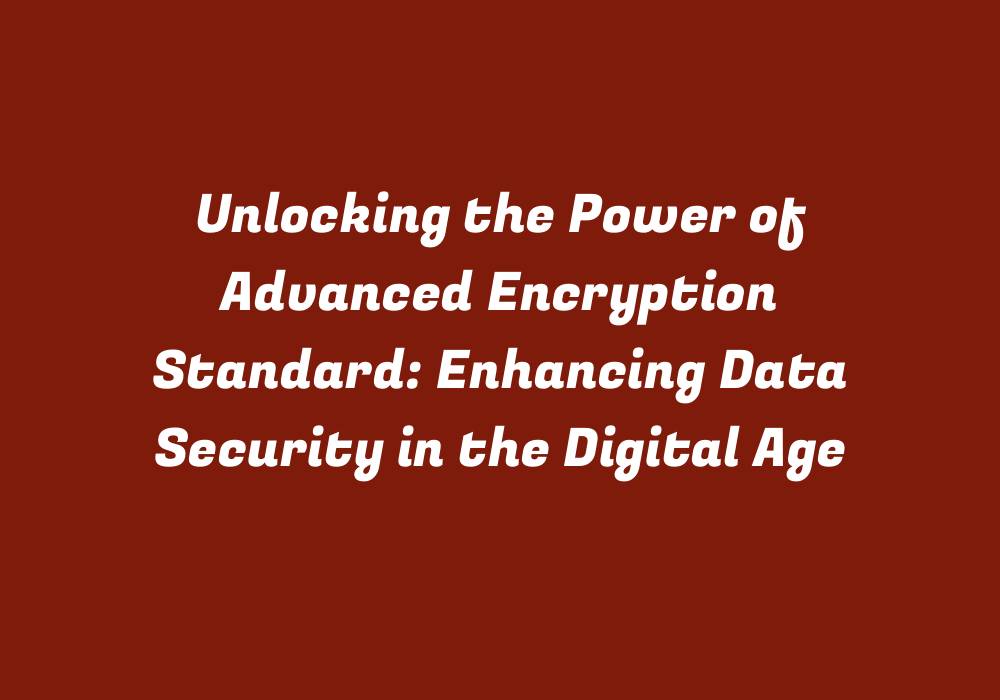Unlocking the Power of Advanced Encryption Standard: Enhancing Data Security in the Digital Age
Introduction to AES and Its Growth in Modern Cybersecurity
In today’s digital era, data security has become a top priority for individuals and organizations alike. With the ever-growing dependence on electronic devices and online platforms for daily transactions and communication, securing sensitive information from hackers or unauthorized access is of utmost importance. Advanced Encryption Standard (AES) is one such method that has proven to be effective in enhancing data security. In this article, we will delve deeper into the concept behind AES and explore its potential for better safeguarding our digital lives in the coming years.
Understanding AES: The Cipher Behind Advanced Encryption Standard
AES is a symmetric block cipher algorithm that was developed by two Belgian cryptographers, Vincent Rijmen and Joan Daemen, as part of a competition organized by the National Institute of Standards and Technology (NIST) in 1997. It has since gained significant traction due to its high efficiency and proven resistance against brute-force attacks.
AES uses a variable-sized key length, allowing for different levels of encryption based on user requirements. The algorithm employs substitution boxes that replace blocks of data with others using a predetermined mapping, along with mixing operations, to scramble the cipher text. This combination of techniques ensures robust and reliable security, making it an essential tool in the modern cybersecurity arsenal.
Applications of AES Across Industries and Platforms
AES is widely used across various industries for securing sensitive data in both digital and physical formats. Some common applications include:
1. Encryption of electronic communications – AES can be implemented to protect data sent through email, instant messaging platforms, or online transactions. By encrypting messages before they are transmitted, this helps prevent interception and ensures privacy for the sender and recipient.
2. Securing digital files and storage systems – From cloud-based solutions to personal computers, AES can be employed to protect stored data from unauthorized access or modification. This encryption technique can safeguard sensitive information like financial records, intellectual property, and confidential business documents.
3. Hardware and software security – As the internet of things (IoT) continues to grow, devices with limited computing power need robust yet efficient cryptographic tools for communication and data transfer. AES is often utilized in implementing security protocols in hardware-based applications like smart cards and software solutions such as virtual private networks (VPNs).
4. Government and military operations – Highly sensitive information often requires the highest levels of encryption to ensure it remains inaccessible to unauthorized parties. Governments and militaries employ AES for safeguarding classified data, communications, and digital assets from potential threats.
The Future of Advanced Encryption Standard in Data Security
As technology advances and hackers continue to refine their techniques, it is crucial to stay ahead of the curve when it comes to protecting our data from unauthorized access. AES has proven its effectiveness over time but will likely continue to evolve alongside emerging threats and vulnerabilities in order to maintain its position as a leading encryption standard. Some potential improvements to AES include:
1. Continued research and development – As new cryptographic techniques are explored, it is crucial for the security community to evaluate their effectiveness and applicability in real-world scenarios. By staying vigilant and continually seeking advancements in data protection methods, we can ensure that our digital information remains secure and confidential.
2. Integration with other encryption standards – Although AES has been successful thus far, it is not the only encryption method available. Incorporating alternative algorithms or combining different techniques may strengthen overall security and provide more robust defense against potential breaches.
3. Enhanced key management – Improving the way encryption keys are generated and managed can play a significant role in increasing data security. Key generation should be randomized, securely stored, and regularly rotated to mitigate the risk of unauthorized access or compromise.
4. Awareness and education – As cybersecurity threats continue to grow, individuals, organizations, and governments must be educated on the importance of robust encryption methods like AES. By understanding its benefits and potential limitations, users can better implement these techniques in their daily lives, thus contributing to a more secure digital world.
Conclusion
In an age where data is the most valuable commodity, protecting it from unauthorized access is vital for both personal and organizational privacy. Advanced Encryption Standard has proven itself as an effective tool in safeguarding our sensitive information, but it must continue to evolve alongside the ever-changing landscape of cybersecurity threats. By staying abreast of new advancements in AES encryption methods and incorporating best practices in data security management, we can ensure that our digital lives remain secure in the coming years.
